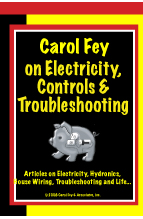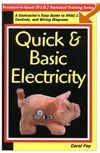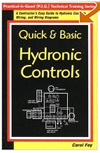by Carol Fey
How can a simple thing be complicated? Easy. So far in this column
you've read that you -- not an electrician -- should be doing
your controls wiring. I have written about the fact that a control
circuit is a simple thing. It is a "circle" of at
least one of each of these three things: power supply, switch
and load.
With a control circuit we're trying to make things go on and
off at the right times. That's done with switches.
Everyone's used to the idea that you turn something on and off
with a switch. Every control circuit must have at least one
switch. Many familiar controls -- thermostats, aquastats, humidistats
-- are simply switches. In fact, anything that contains the
letters "-stat" is probably a switch.
If you come from plumbing, it may seem odd that a switch is
closed when it's on, and open when it's off. That can seem backwards
because with valves, open means that stuff flows, right? Closed
means that stuff stops. Switching action is the opposite of
valve action.Inside A Simple Switch
A switch is like a drawbridge. Picture the drawbridge closed.
There's a path for the electricity to flow on. Then picture
the drawbridge open. There's a break in the path, and the electricity
cannot flow.
Here's my electricity drawbridge fantasy. It's a glorious sunny
day. The local track team made of fast, hot little electricity
guys is out for its daily run. In fact, they're wearing tiny
electric blue jogging shorts that glisten in the sun. Every
day they start out and make a circuit through the town, crossing
the bridge, back to where they started. They trot along effortlessly,
hardly even varying their pace.
Then one day the bridge is up. They have to stop and can go
no further. Until the bridge goes back down, they can keep jogging
in place. Or they can sit down and watch the birds fly by. But
they can't go around, and they can't go over the bridge until
it closes. But as soon as the bridge closes, they start up again
and complete their circuit back to where they started.
Well, if switches are like drawbridges, then they're pretty
simple. Then along comes our electrician buddy, and he says,
"OK plumber dude, you think you know so much, is that switch
of yours a SPST or SPDT?" Isn't that how it goes? As soon
as you think you know something, some guy's gotta point out
that you don't!
What is this four-letter switch stuff?
Switches are sometimes identified with a four-letter code. S
stands for single, D for double, P for pole, and T for throw.
You already understand single and double.
But before we go any farther, let's go back to the drawbridge.
The drawbridge makes me think of a river. A river makes me think
of fishing. And fishing makes me think of a fishing pole. The
pole in a switch is a lot like a fishing pole.
A pole connects two points. If you hold one end of a fishing
pole and your buddy holds the other, we're talking about a single
pole. If you have two more buddies standing beside the two of
you, and a separate pole connects them, you have double poles.
There's no connection between the two poles. The pole situation
is the same in switches. But in switches, the two poles have
to connect or disconnect at the same time.
Keep thinking about fishing. Now let's talk about throws. You're
holding the pole. When you cast, or throw, so that the pole
connects you and your buddy, that's single throw. If you then
cast behind and connect with another buddy, that's double throw.
The rule is that you can connect with one buddy or the other,
not both at once. The same rule applies to poles and throws
in switches.Four-Letter Words
Put all of this together, and you have four possible combinations
of poles and throws--SPST, SPDT, DPST and DPDT. Don't sweat
these. In control work almost all our switches are SPST. That's
the simplest type, just like a light switch. We turn one thing
on or we turn that same thing off -- single pole single throw
(SPST). Turning it on is making the connection, which we call
the throw. Turning it off is removing the connection.
Let's talk about that in another way. The 1950s and'60s were
an SPST world. When I was a kid, my grandma lived in an old
wooden farmhouse with an old wooden porch and an old wooden
screen door. On Sunday afternoons, the adults would sit inside
and talk and talk and talk and I would get restless and b-o-r-e-d.
Finally Grandma would say, "Why don't you go out and play
on the porch?" I'd head for the door.
It was one of those floppy ones with the spring attached. I'd
push the door open, go through it, let go, and it would slam
shut with a "ka-whap." Hey, that's fun, my kid brain
noticed. Let's do that again. From the outside, I'd pull the
door open again, and let it go. Ka-whap. Next time I'd pull
it open even farther. Ka-whap it would go, even louder. I'd
keep that up until a grownup voice from inside yelled, "Stop
slamming that door!" The switching action on that door
was single pole, single throw. I applied power to open and hold
it open. When I let go, I removed power and the spring slammed
the door shut. That was a simple SPST world.
My own kids grew up in an SPDT world of doors. With air conditioners
and airtight houses, the old wooden screen door with the spring
became a thing of the past. Regardless of the season, the solid
front door is to be shut. You open it, and (supposedly) you
close it behind you. Power open, power closed. One throw to
power it open. The other throw to power it closed. Instead of,
"Stop slamming that door!" my kids heard, "Shut
that darn door, will ya?"Committee Meeting
Nearly all of the switches we use in control circuits are SPST.
The switches are very simple. Yet switching can appear to be
very complex. In fact, switching is probably what makes controls
seem complicated. How can a simple thing be complicated? Switching
gets complicated because we often use many switches in a single
circuit. That's because we want many conditions to be just right
before the circuit can operate.
I think of switches in a control circuit as a committee. Each
switch is in charge of making a particular decision. The thermostat
is in charge of deciding if heat is needed. The high-limit switch
(probably an aquastat) is in charge of whether or not the temperature
inside the equipment is too hot. The low-water cutoff is in
charge of making sure there's enough water in the boiler.
Like in a company or a family, if there is just one decision-maker,
it's easy to understand where the decision is coming from. But
if there is a committee where all have to agree, it gets harder
to understand how a decision got made.
Now picture those controls -- the thermostat, high limit and
the low-water cutoff -- all standing in a row. In technical
talk, this would be called in series. The question up for vote
is, shall we bring on the burner? All three have to vote yes
for it to happen: yes, there's a need for heat; yes, it's safe
to bring on the burner because it's not already too hot in the
equipment; and yes, there's enough water in the boiler.
Ah, yes, one more piece of complexity. Ever work with a group
of decision-makers when you don't know who they are or how many
there are? That happens with controls too. And the bottom line
is, once you figure out who they are, folks is just folks, and
switches is just switches. |




